I

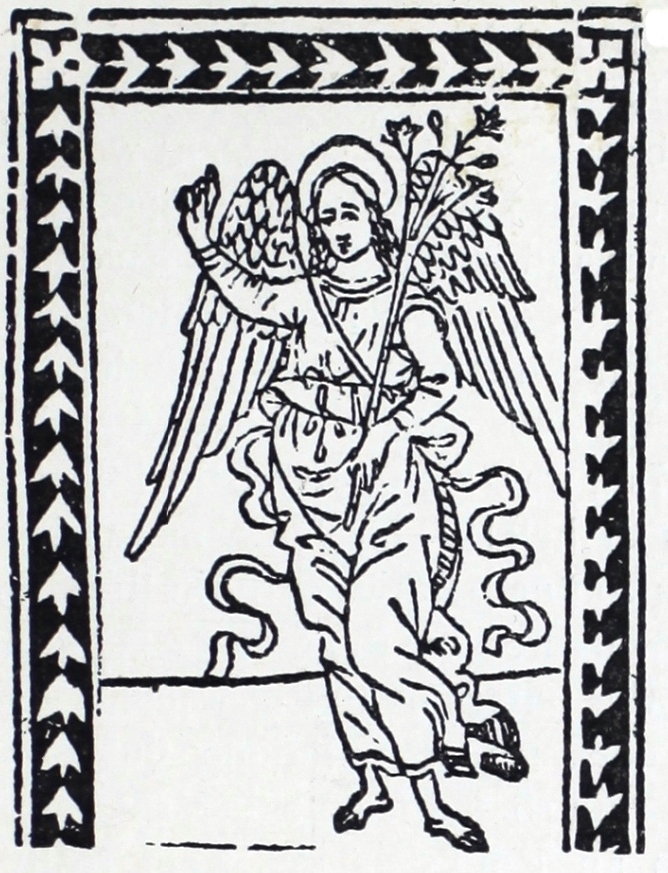
Il Opretta di frate Girolamo de ferrara della ozatione mentale
della ozatione mentale
I

very
inadequate;
and the fact re-
mains that in only
one country,
and
practically only
in one city in that
country (for the
Sienna editions
are merely re-
prints) did the
religious
plays,
which in one
form or another
were then being
acted
all over
Europe, receive
any contemporary illustration.
This one city was Florence; and
alike for the special form
in which the religious drama was there de-
veloped, for
the causes which contributed to its popularity at the turn of
the fifteenth
and sixteenth centuries, and for its close connection with
the popular art
of the day, the subject is one of considerable interest.
On its literary
and religious side, the late John Addington Symonds dis-
cussed it in Studies of the Italian Renaissance with his usual
ability,
and many of the plays have been reprinted by Signor Ancona. Of
late
years the little pictures by which they are illustrated have also
received
attention, a fact amply attested by the extraordinary rise in
their
market value. But it is worth while to bring together, even if only
in
outline, the pictures and the plays to which they belong, more
closely
than has hitherto been attempted, and this is my object in the
present
paper.
Book-illustration in Italy began very early with the
publication in
1467, by Ulric Hahn, at Rome, of an edition of
the Meditations of
Cardinal
166
II
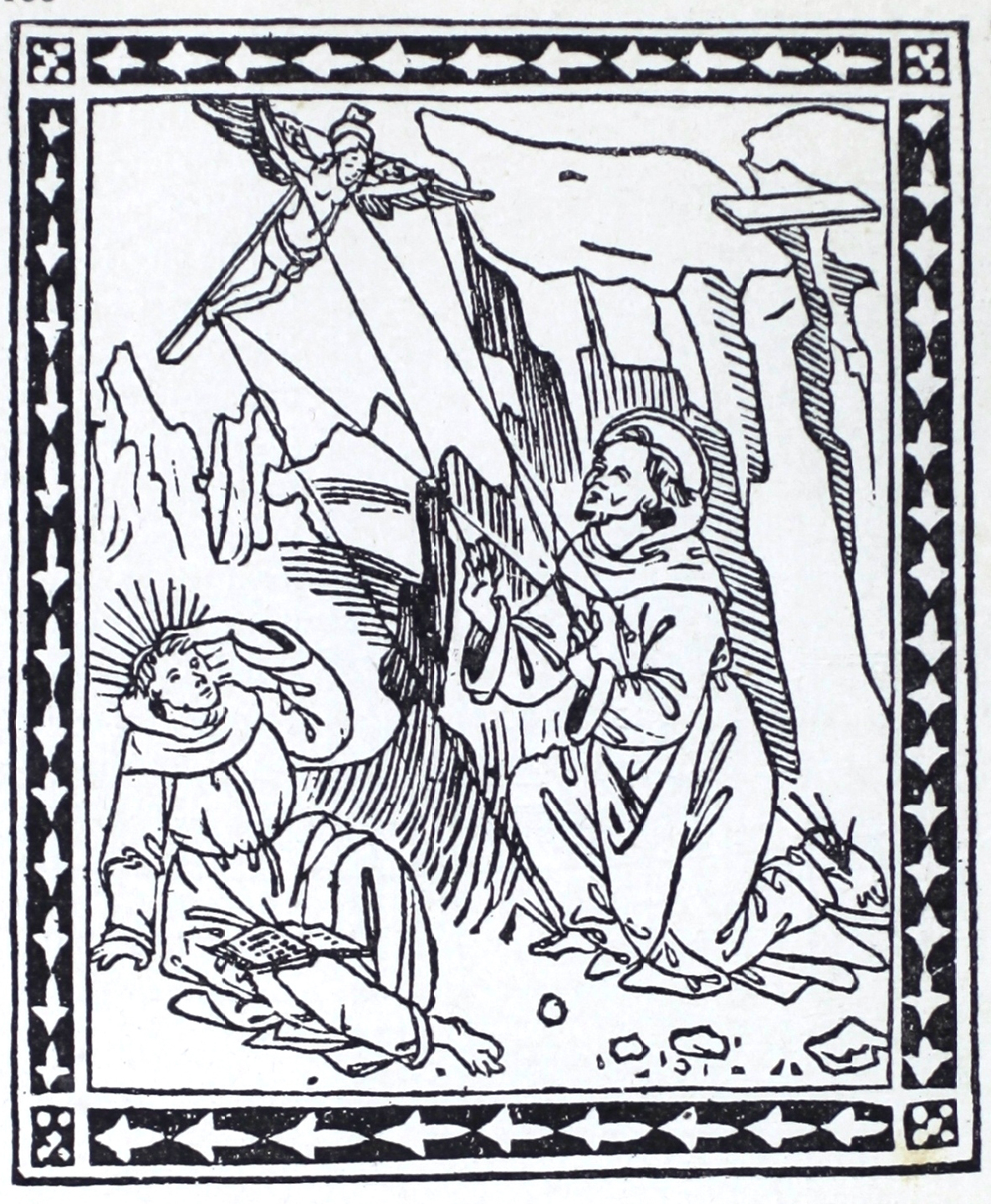
III
and must be
looked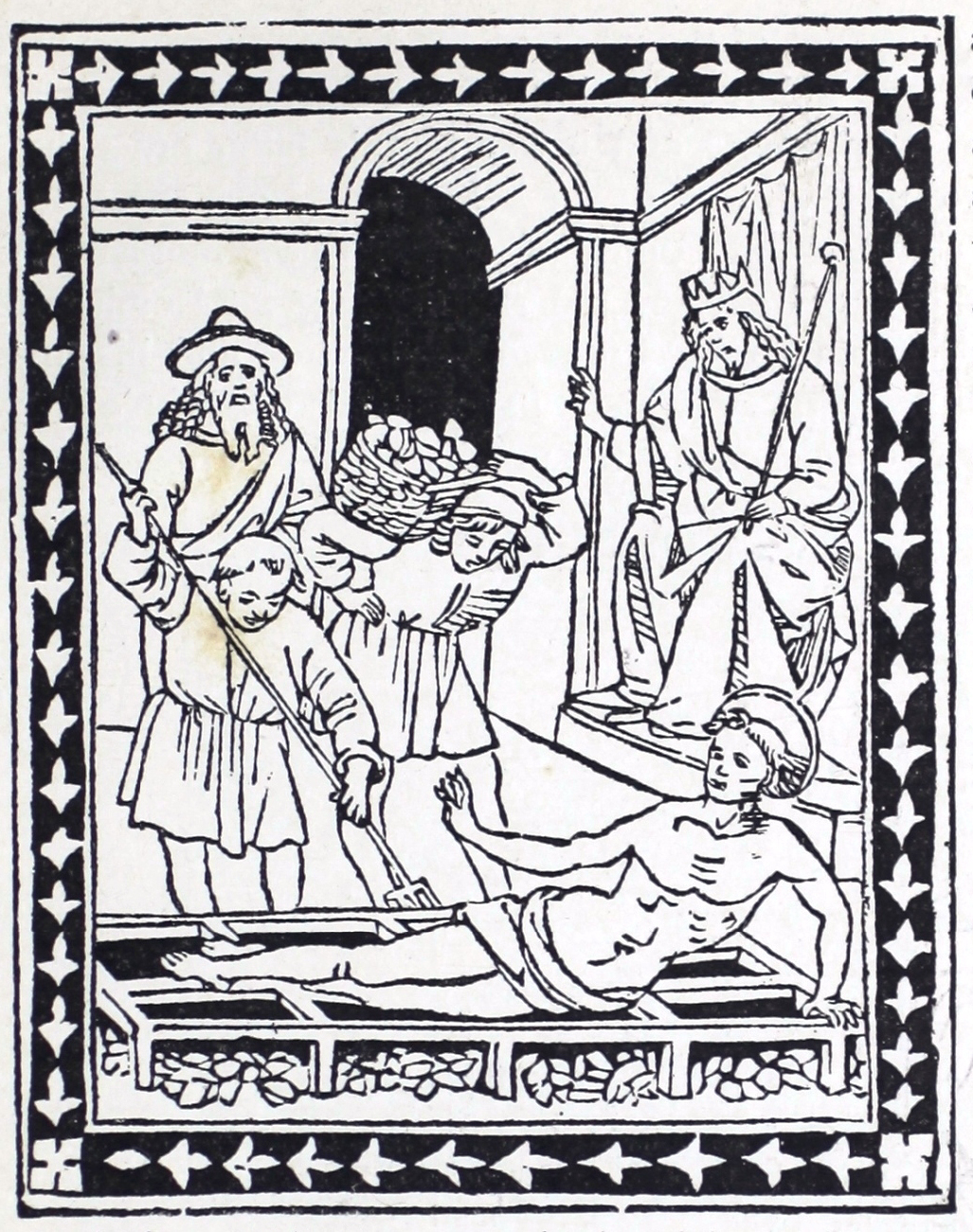
on only as an ex-
ample of the spor-
adic illustrations
of
which we have
spoken as appearing
in other districts.
But
from the 28th
of September, 1490,
onwards for twenty
years, we
have a
succession of wood-
cuts which, amid
all the
differences
which give them
individuality, are
yet closely
linked
together in style,
and which form, on
the whole, by
far the finest series of book-illustrations of early date.
The
popularity which these woodcuts attained is attested by the
repeated
editions of the works in which they appear; while the suddenness
with
which they sprang up, the general similarity of style, and the nature
of
the books they illustrate, all suggest that we have here to deal with
a
conscious and carefully directed movement as opposed to the
haphazard
use of illustrations in other cities during the previous twenty
years. The
book in which the first characteristic Florentine woodcut
appears is an
edition of the Laudi of Jacopone
da Todi, printed by Francesco Buonac-
corsi; and both the choice of the
book and the name of the printer
offer a tempting basis for theory-making.
Printing, we must remember,
though it had been in use for more than a third
of a century, was even
then a new craft, and was still taken up sometimes
as a side-employ-
ment by many persons who had been bred to other trades or
professions.
Our own Caxton, as we all know, was a mercer; the first
printer at St.
Albans, a schoolmaster; Francesco Tuppo, of Naples, a
jurist;
Joannes Philippus de Lignamine, of Rome, a physician; and so on. In
natural
168
natural continuation, however, of the
work of the Scriptorium in many
monasteries, we find that a large number of
the early printers were
members of monasteries or priests, and it was to
this latter order that
the Buonaccorsi who printed the Laudi belonged. Now, the name
Buonaccorsi is the name of the
family of Savonarola’s mother. A
few months before the appearance of the
Laudi the great Dominican
had been recalled
to Florence by Lorenzo de’ Medici, and his first
public sermon there—a
sermon which had stirred the whole city
to its depths—had been preached on
the previous 1st of August. In
IV
the
next year we find Buonaccorsi printing the first edition of That this should be the case would not be surprising.
Savonarola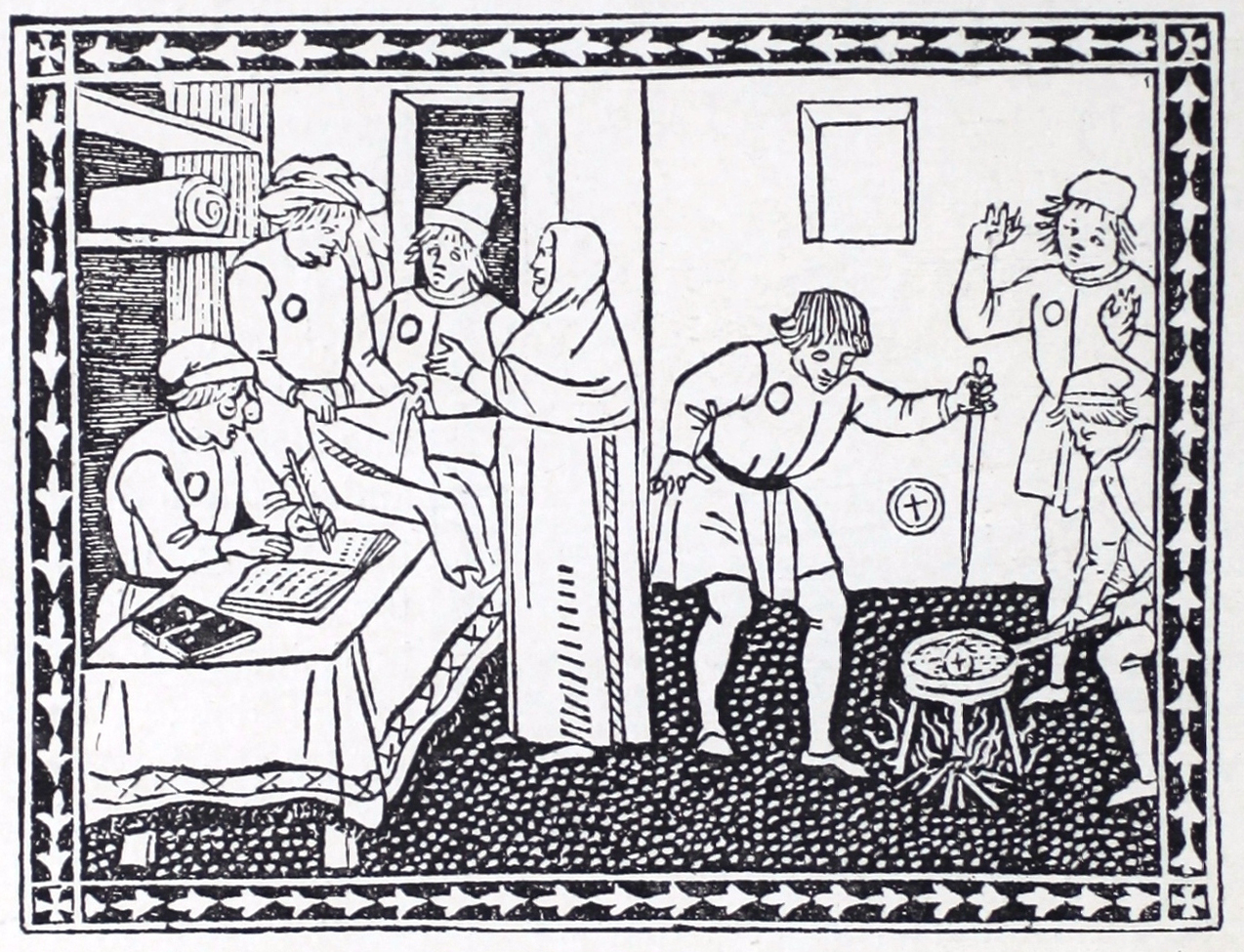
the Libro della vita viduale, the earliest dated Savonarola
tract o
which I know; and I have not been able to resist hazarding the
conjecture that between the preacher-monk and the priest-printer
there may
have been some tie of blood, and that it was to Savona-
rola that the
splendid series of Florentine illustrated books owe
their origin.
was no Puritan, or rather he was like the Puritans of
the better sort,
and loved art so long as it was subservient to the main
object of man s
being. The pamphlets with which he flooded Florence during
the next
few years are, for the most part, decorated with a cut on their
first page
or
169
V
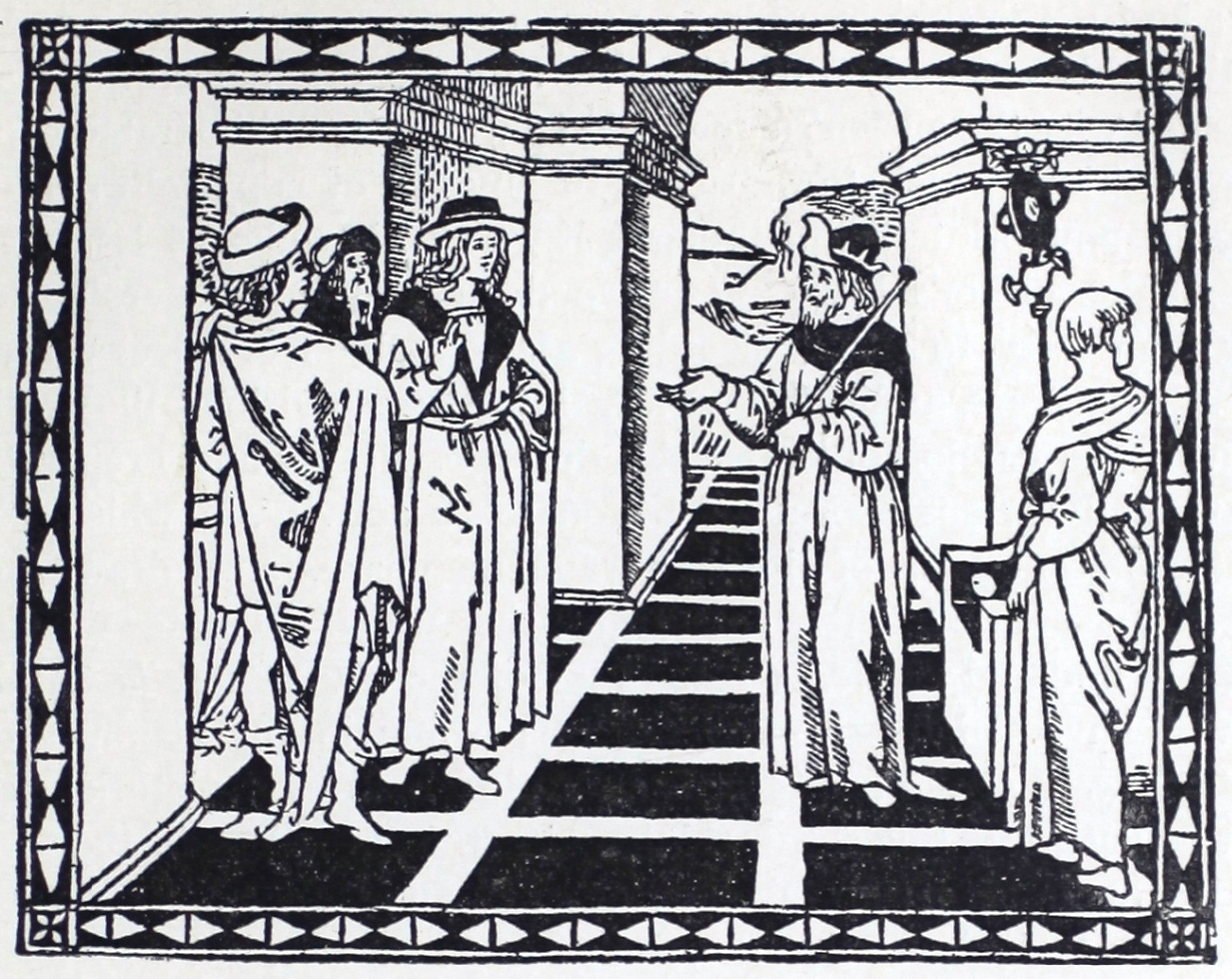
VI
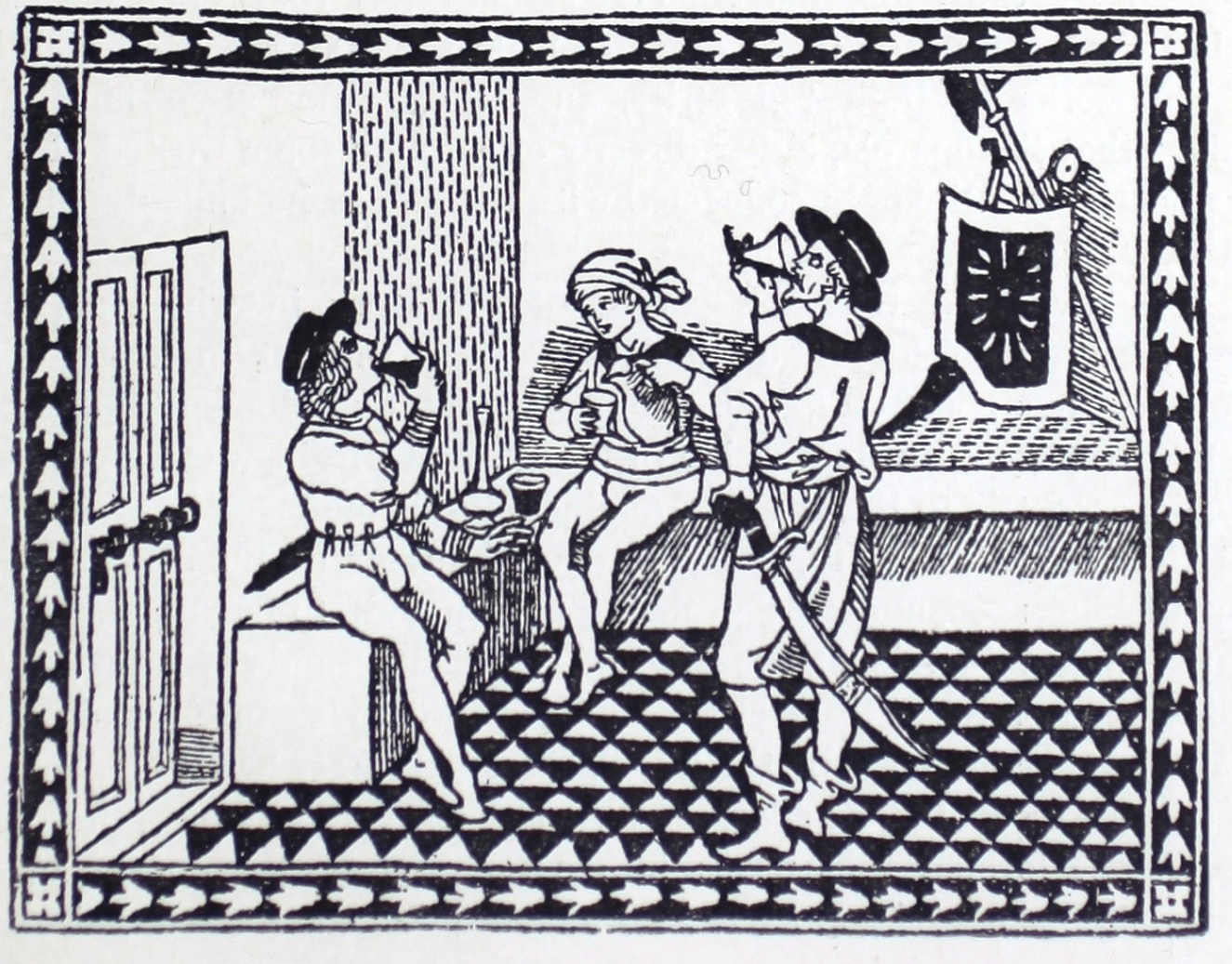
170 We have said that the choice of the work in which
appeared
or title; and if the subject were ever
worked out, it would probably be
found that this was uniformly the case
with the original editions, and
those issued with the author’s supervision;
while the unillustrated copies
are mere reprints, which the absence of any
law of copyright made it
possible for any printer, who thought it worth his
while, to issue, with
or without the author’s leave. The woodcuts to the
Savonarola tracts
number from forty to sixty, according as we include or
reject variants
on the same subject, and fall naturally into three
divisions, illustrating
respectively the Passion of Christ, the duties of
Prayer and Preparation
for Death, and various aspects of Savonarola’s
activity, in which, how-
ever, the representations of him are always
imaginary, never drawn from
life. As an example of these cuts, I give that
which decorates the title-
page of an undated edition (circa 1495) of the
Operetta della oratione
mentale. I have had occasion to use this before in my
little work on
Early Illustrated Books, but there is a certain
largeness of pictorial effect
about it which gives this cut, I think, quite
the first place in the series,
and makes me unwilling to take any other as
an example. The cuts in
the Rappresentazioni are
seldom quite as good as this, but they form a
parallel series to those of
the Savonarola tracts, occasionally borrowing
an illustration from those on
the Passion of Christ, and evidently
inspired by the same aims. The same
types (our only means of
fixing the printers of these dateless little
books), were used in many
of the works of both the series, and it does not
seem fanciful to
believe that Savonarola, either directly or through some
trusted disciple,
was nearly as intimately connected with the one as he
undoubtedly was
with the other.
the first typical Florentine woodcut was not without
interest for our
subject. Jacopone da Todi, whom the cut exhibits kneeling
in an
ecstasy of prayer before a vision of the Blessed Virgin, was a
Franciscan
mystic, eccentric to the verge of madness in his manners, but a
spiritual
poet of no mean ability, and the reputed author of the Stabat Rater.
He died in 1306, and was probably
old enough to have remembered
that strange epidemic of the Battuti, when thousands of frenzied men
and women
marched from city to city, scourging themselves almost to
death for the
sinfulness of the world, till their career had to be stopped
by the free
use of the gallows. When the frenzy was past, those who
survived it formed
themselves into companies for the continuance of
their religious exercises
in a more moderate form, and from their meet-
ing
175
VII
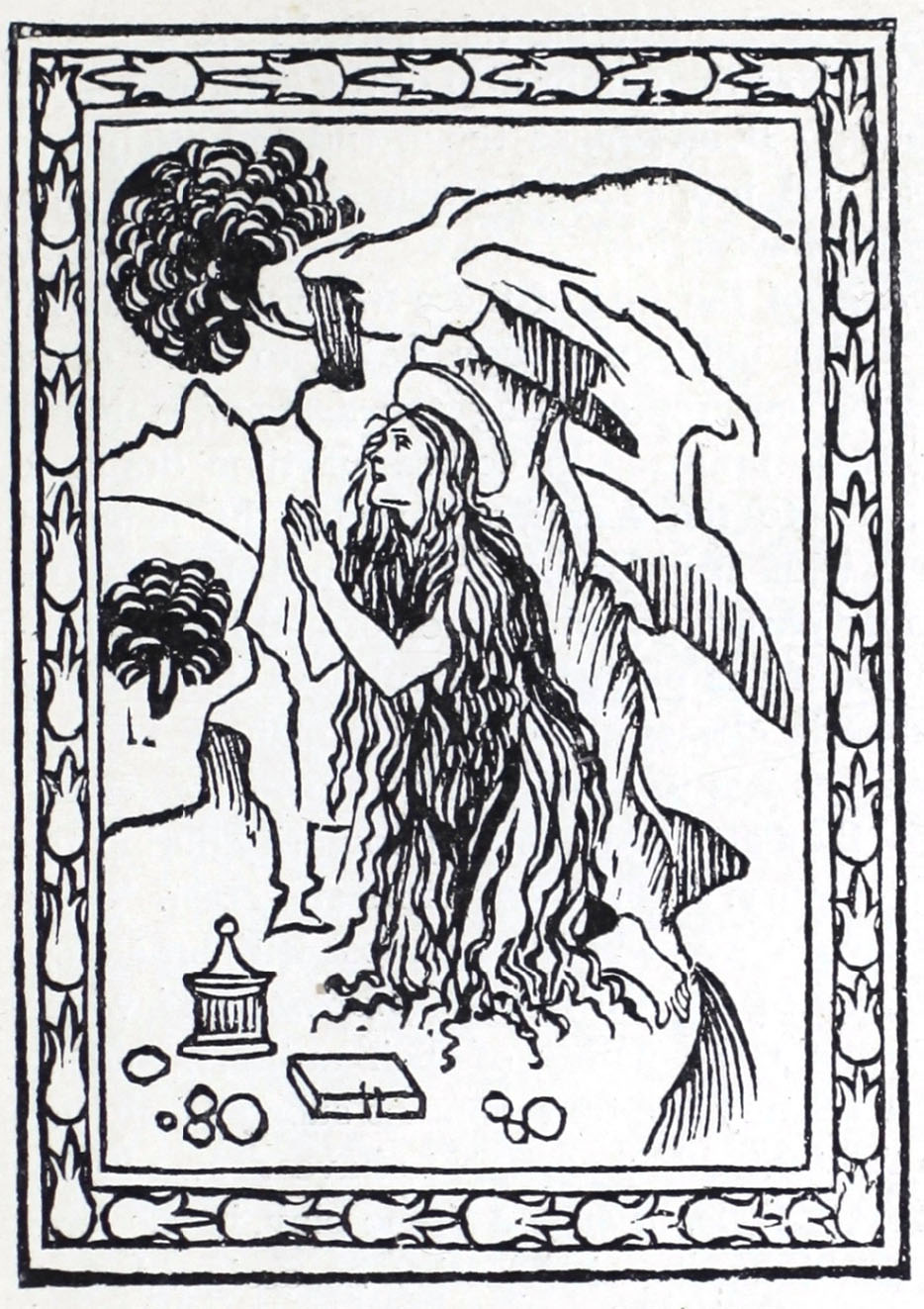
ing
together to sing their In an edition of the Laudi of the
first of these two writers, seen by Unlike the northern Miracle Plays, which are almost without
excep- The earliest Rappresentazione
printed was the Abraham of the
Maffeo,
Laudi, hymns of a peculi-
arly personal fervour,
in
the chapels of their
guilds, they obtained the
name Laudesi. Of the
writers of these Laudi,
Jacopone da Todi was
the greatest, and
it was
out of the Laudi that the
later
Rappresentazioni
were gradually
developed.
In his excellent account
of the Rappresentazioni,
to which I have already
alluded, Mr. J.
A.
Symonds seems to me
to have laid rather undue
stress on the
manner in which this development took place, as offering a
contrast to the history of the religious drama in other countries.
It
is true that in England the plays which have come down to us
belong
almost exclusively to the great cycles which unrolled the
history of man
from the creation till the crack of doom, but we have
mention of several
plays on the lives of the Saints—e.g.one on St.
George
and the Dragon, and another (which survives) on St. Mary
Magdalene,
and the popularity at one time of these Miracle Plays, properly
so
called, is witnessed by the fact that it is their name under which
the
cycles of Scriptural dramas generally passed. At Florence these
longer
dramas were not wholly unknown, but they seem to have been
acted
only in pantomime or dumb-show, in the great pageants on St.
Johns
Day; the shorter plays developing from the Laudi just as, at an earlier
period, the liturgical dramas had
developed in France and England out
of the dramatic recital of the gospel
of the day. It is worth noting, by
the way, that the Laudi themselves were not superseded, but continued to
be
written and sung when the Rappresentazioni were
already becoming
popular.
176
popular. Two of the writers of them
during this period have a special
interest for us—Maffeo Belcari, as the
author also of the earliest printed
Rappresentazioni, and Girolamo Benivieni, as the
friend and disciple of
Savonarola, whose doctrine and prophecies he
defended in 1476 in a
tract, printed, this also, by Buonaccorsi.
Mr. Symonds, but which I am
unlucky enough never to have come
across, there is an interesting cut
representing the Laudesi, standing
before a
crucifix, singing their praise. In course of time dramatic
divisions had
been admitted into the Laudi, and under the name of
Divozioni they were recited with appropriate action
in dialogue form.
The actors were for the most part boys, who were formed
into confra-
ternities, while the expenses of the plays were doubtless
defrayed by
their parents. As the dramatic element in the performances
became
more decided, the plays came at last to be generally termed Rappresen-
tazioni, and under this name they attained a great
popularity during the
last quarter of the fifteenth century, and the first
of its successor.
tion anonymous, the majority of the earliest Rappresentazioni which
have come down to us
contain the names of their authors, and in
editions separated by half a
century the text remains substantially un-
altered In English plays the
text often appears to have grown up by
a process of accretion, so that a
cycle, or even a single play, in the form
in which it has survived, could
hardly with justice be assigned to a
single author, even if we knew the
name of the first writer concerned in
it. The difference is not
unimportant, and is one of numerous small
signs which tell us that the
religious drama in Florence, at least in this
stage of its development, was
less popular, less spontaneous, than in our
own country, and more the
result of deliberate religious effort.
or Feo, Belcari, whom we have already mentioned. It was
printed in
1485 the year after Belcari’s death at a good old age (he was
born in
1410), so that the whole of Belcari’s plays were published
posthumously.
Among them are plays on the Annunciation, on St.John the
Baptist
visited by Christ in the Desert, and on St. Panuntius. Of the last
two
of these I have seen fifteenth-century editions—the one at the
British
Museum, the other at the Bodleian Library, each with a single
charm-
ing woodcut. No less a person than Lorenzo de’ Medici was the
author
of the play of S. Giovanni e S. Paolo,
which has also come down to us
in
VIII
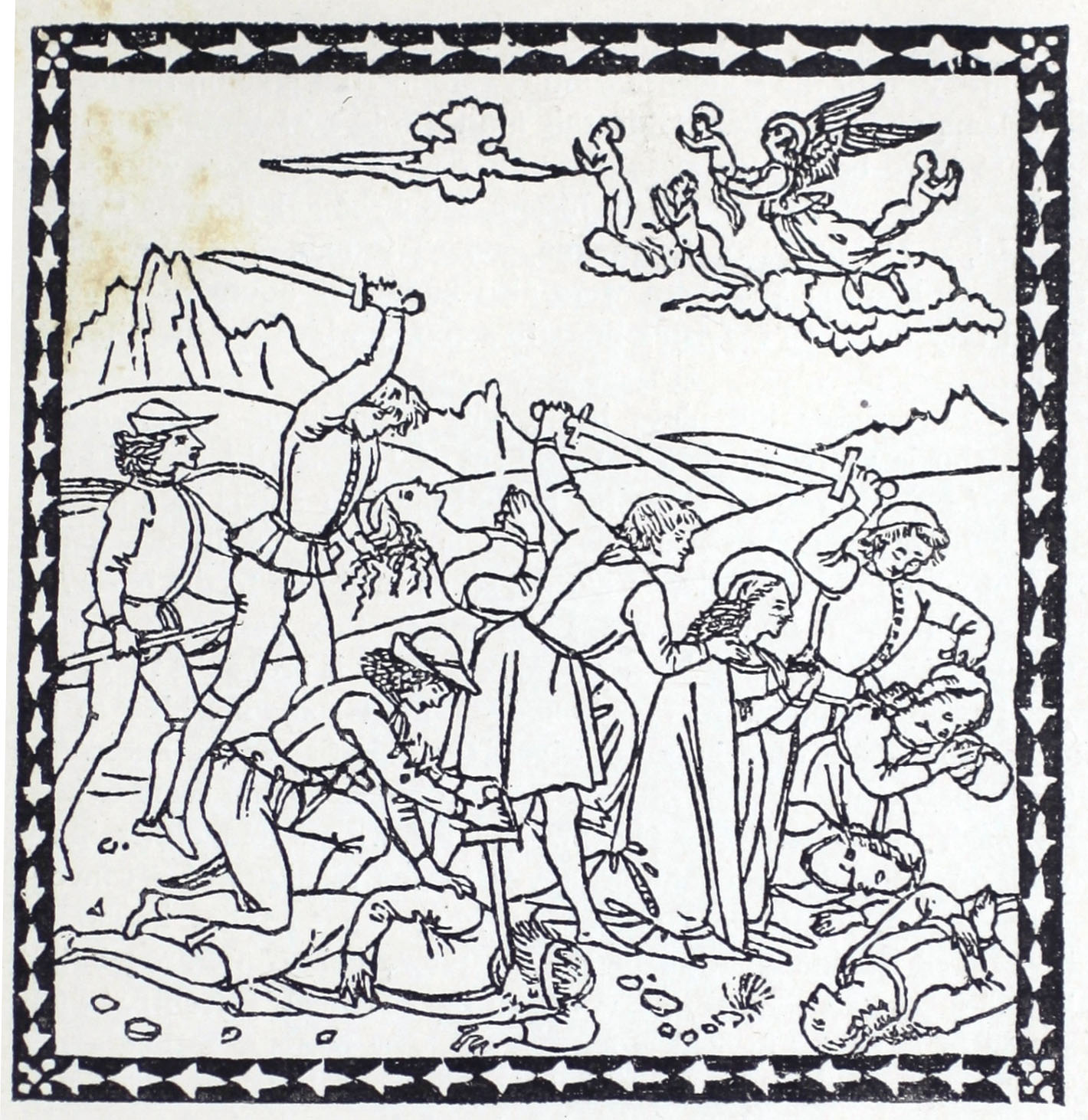
178 Almost invariably the plays begin with a Prologue spoken by
an Of the literary value of the Rappresentazioni it is not possible to
in its original edition with a
graceful cut; and Bernardo Pulci, who died
in the first year of the
sixteenth century, produced a play on the legend
of Barlaam and Josaphat.
But the most prolific of these dramatists
seems to have been a woman,
Bernardo’s wife Antonia, to whose pen
we owe plays on the Patriarch Joseph,
the Prodigal Son, S. Francis
of Assisi, S. Domitilla, S. Guglielma, etc.
The names of a few other
writers are known; but there were also numerous
anonymous plays,
written very much on the same lines, to some of which we
shall have to
allude.
Angel, who is represented in the title-cut of Lorenzo de’
Medici’s San
Giovanni e San Paolo as standing behind the two
saints in a kind of
pulpit. In other early plays the Angel is represented
in a separate
woodcut whose lower border is cut off, so as to fix on to the
border of
the special title-cut of the play. Later on, another design was
substi-
tuted for this, without any border at all. I think it probable that
these
angelic prologuisings were mostly spoken from some machine at
the
back of the stage, especially contrived for celestial appearances.
In
other respects, the services of the stage-carpenter do not seem to
have
been much called for. The plays were acted, we are told, either in
the
chapel of the guild or confraternity, or in the refectory of a
convent,
and the arrangements were probably very similar to those in modem
school-plays, the imagination of the spectators being often required
to
take the place of a change of scene. In the so-called ‘Coventry’
Plays
we hear of a device by which a new scene, or perhaps rather a
new
centrepiece, with the actors all in their places, could be wheeled
round
to the front; but more often the whole of the dramatis personce
were
grouped at the back or sides, and individual actors merely stepped
for-
ward when their turn came. In the play of San
Lorenso we are
expressly told that two scenes were shown
simultaneously on different
parts of the stage, Decius and his satellites
offering their heathen
sacrifices on the one side, while Pope Sixtus
comforts the faithful against
the coming persecution on the other. This
combination of two scenes
in one is a familiar feature in mediaeval art,
and is not unknown even in
these Florentine woodcuts, small as they are:
witness our fourth cut, in
which the bartering at the pawnshop, and the
indignities offered to the
sacred wafer, tell the story of the play by
means of its two most
prominent scenes.
speak
179
speak with much enthusiasm. From a
literary standpoint, indeed, the
lives of the Saints, with which most of
them have to do, are a difficult
and not very promising subject. Most
stories of heroism are best told
in ten lines at longest; and to attempt to
spin them out into several
hundred, without any considerable material in
the way of authentic
detail, leads inevitably to weakness and exaggeration.
In this respect
the Rappresentazioni are neither
much worse nor much better than the
average Legenda
Sanctorum in verse or prose. They follow these, in
fact, with
remarkable fidelity, and as they are written for the most part
IX
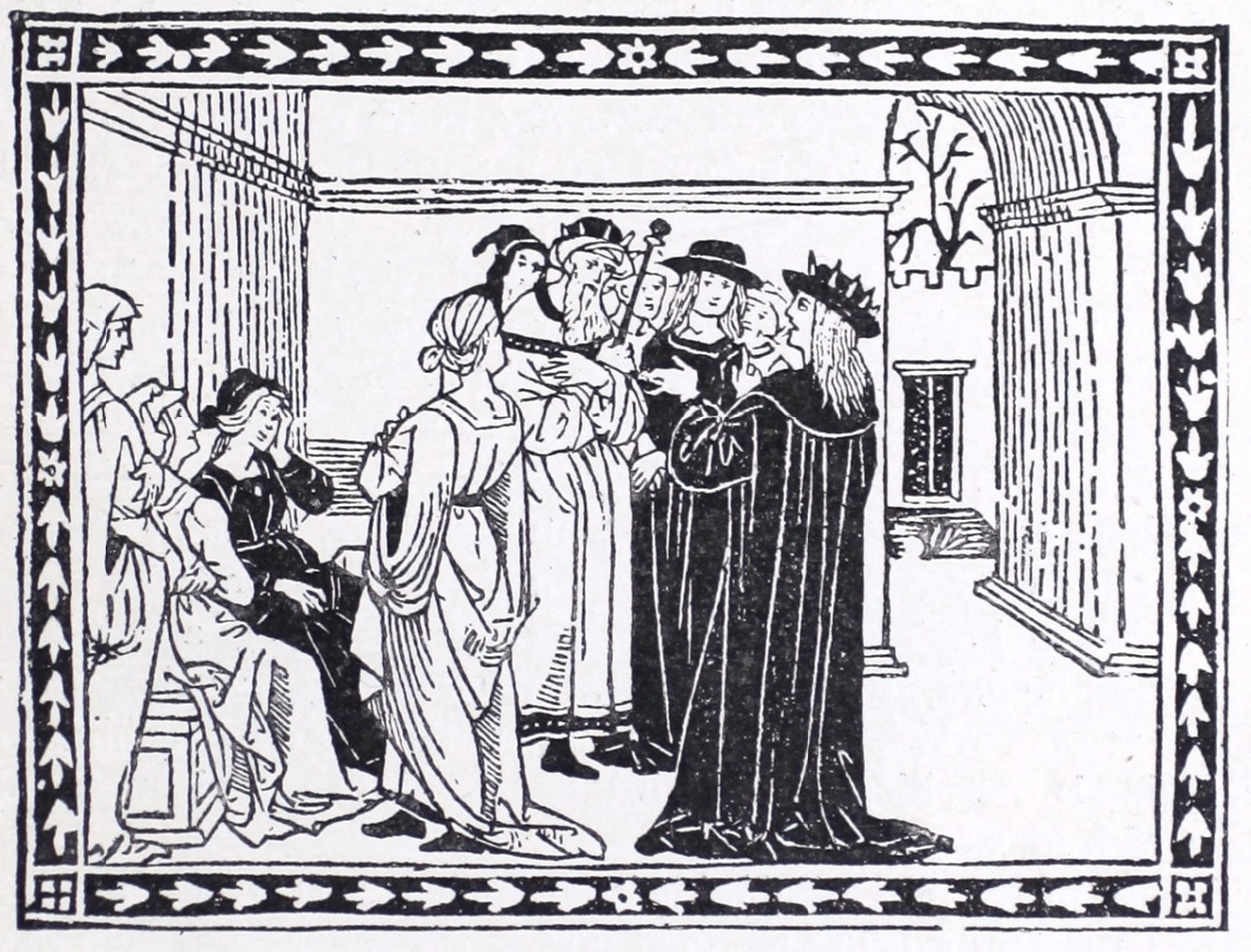
in
the familiar octava rima, it is only by the speeches
being made in the Both these plays belong to the fifteenth century, and, as is
mostly This play of the Corpo di Christo
is an Italian version of a miracle
first person, instead of in historical narration, that
they differ very greatly
from them. Thus, to take the plays from which we
have chosen our
illustrations, that of S. Francis of Assisi, by Antonia
Pulci, faithfully
records all the main incidents as told in the legends—the
colloquy with
the beggar during which he was stricken with compunction, the
theft
from his father of money to repair a church, the founding of his
Order,
the conference with the Pope, and the reception of the stigmata;
this
last being, as might be expected, the subject chosen by the artist for
the
woodcut on the title. The play of S. Lorenzo
shows us the martyrdom
of Pope Sixtus in the Decian persecution, and then
the torture and
death
180
death of S. Laurence for his refusal
to surrender the treasure which the
Pope had bequeathed to the poor of the
church. Both of the woodcuts
to these two plays are of great beauty. The
first probably follows the
traditions of the many pictures on the subject
rather than that of the
stage, though it was, no doubt, for a scene like
this that the stage-
managers of the day used their utmost resources. In
the martyrdom of
S. Laurence, on the other hand, we may be sure that we
have a very
exact picture of the scene as played on some convent stage.
the case in the earliest editions, have only a rough
woodcut each. This
was not invariably so, as in the Bodleian Library there
are copies of
editions of the plays of Stella
and S. Paulino, which have every appear-
ance of
having been printed before 1500, but yet have sets of several
cuts, all
obviously designed especially for them. These, however, are
exceptions; and
as a rule where we find several cuts, it is easy to trace
most of them
back, either to other plays, or to other illustrated books
of the time,
such as the Epistole e Evangelii, the Fior di Virtù, Pulci’s
Morgante Maggiore, etc. Thus, of the two cuts given
here as illustra-
tions to the curious Rapresentatione
duno miracolo del corpo di Christo,
the first alone occurs in
the fifteenth-century edition, while in that of
(probably sixty years
later) this original cut reappears, with three
others added to it. The
first, here shown, representing a drinking
scene, is borrowed, I strongly
suspect, from the Morgante Maggiore;
while the
second, which shows a man being burnt, and the third, in
which a king is
consulting his council, may be called stock-pictures, and
reappear with
frequency.
which was constantly being
reported during the middle-ages, and was
often the excuse for a cruel
persecution of the Jews. The well-known
‘Croxton’ Play
of the Sacrament is cast on the same lines, and a
detailed
comparison of the two would yield some points of interest. In
the Rappresentazione the story is well told, and with
unusual vivacity.
After the angelic prologue there is an induction, in
which a miracle of a
consecrated wafer, dripping blood, is announced to
Pope Urban, who
discourses on it with a cardinal and with S. Thomas Aquinas
and S.
Bonaventura. The play then begins with a drinking scene, in w
ic
a wicked Guglielmo squanders his money, and then takes his wife’s
cloak to the Jewish pawnshop to get more. The poor woman goes
herself to
the Jew to try to get her cloak back, and is then persuaded to
filch
181
filch a wafer at mass and bring it to
the Jew, on his promise to restore
her garment. Her horror at his proposal
is overcome by the pretext
that his object is to use the Host as a charm to
heal his sick son, and that
if this succeeds he and all his family will
become Christians. This, of
course, is a mere fiction, but it serves the
woman in good stead; for when
the Jew is discovered by the unquenchable
flow of blood from the wafer
he maltreats, he is promptly burnt, while the
Judge is warned by a
X
special
revelation to spare the life of his accomplice, whose guilt might An edition of the play of S.
Cecilia, probably printed about 1560, One point in the text of the S.
Cecilia deserves noting. In the main Whatever the shortcomings of the Rappresentazioni, their
popularity As the Rappresentazioni and their
illustrations are connected with the As to the authors of these charming woodcuts, we know
absolutely ALFRED W. POLLARD.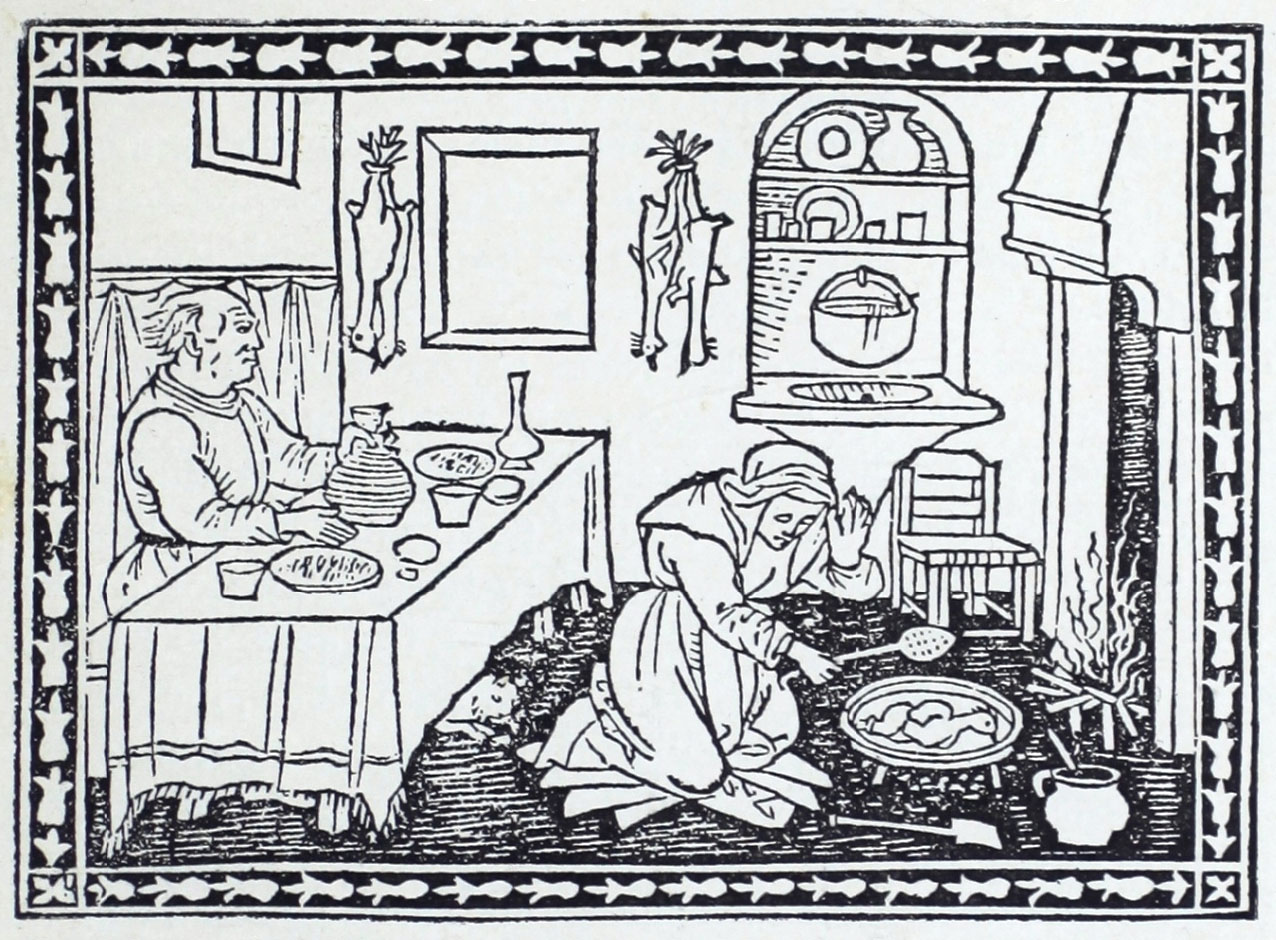
easily be
represented as the greater of the two.
affords a good
example of the gradual addition of cuts in later reprints.
This little
tract of about twenty pages has no less than eighteen pictures
in it, three
of which, however, are only repetitions of one of the most
familiar cuts in
the whole series of Rappresentazioni—a Christian
virgin
dragged before a king; while three other well-worn cuts are
each
repeated twice, so that the number of blocks used was only
thirteen,
though these yielded eighteen impressions. As might be expected,
the
little pictures are often dragged in with very little
appropriateness.
Thus, the Roman soldiers sent to arrest Cecilia gave the
publisher an
excuse to show a party of knights riding in the country, and
so on. On
the other hand, the little picture here shown of a disputation,
though un-
doubtedly executed in the first instance for some other work, probably
gives
182
gives us a very correct representation
of the costume and grouping of
the actors, and the same may be said of the
companion picture from the
play of S.
Orsola.
it resembles
very closely indeed the legend as it is known to lovers of
English poetry
from the version which Chaucer made in his early days
and afterwards
inserted, with little revision, into the Canterbury
Tales.
But when Cecilia has gone through the form of marriage
with the
husband who is forced upon her, and is proceeding with him to
his
home, the lads of the neighbourhood bar their passage with a demand
for petty gifts, to which the virgin submits with good grace—a
fragment
of Florentine life thus cropping up amid the rather unreal
atmosphere
of the old legend.
was very great, and they were reprinted again and
again throughout the
sixteenth century. Naturally the woodcuts suffered
from continual use,
and the stock-subjects, like that of a general
martyrdom shown in cut 8,
are often found in the later editions with their
little frames or borders
almost knocked to pieces. Recutting was also
frequent, and in the
same edition of the play of S. Mary Magdalene, from
which, for the sake
of the unusual freedom in the handling, I have taken
the title-cut as
one of our illustrations, it is repeated later on from a
new block, clumsily
cut in imitation of the old one.
Savonarola tracts on the
one hand, so on the other we find them
influencing some less dramatic forms
of literature. Thus, among the
early Florentine illustrated books we find a
number of Contrasti—the
contrast of men and
women, of the living and the dead, of riches and
poverty, etc. These were
rather poems than plays, but the name
Rappresentazione is sometimes applied to them in
later editions. This
is so, for instance, with the famous Contrasto di Carnesciale e la Quare-
sima, from which the first of the two cuts is here
given, the second
representing a visit to the fish and vegetable market for
Lenten fare
when the days of Carnival are over. Again we find the same
methods
of illustration applied to the Giostre
of Giuliano and Lorenzo de’ Medici,
the story of Orpheus, by Angelo
Politiano, which forms part of the
former, being adorned with no less than
ten admirable woodcuts, of
which the picture here reproduced, of Orpheus
frightened by a fury from
attempting a second time to visit Hell in quest
of his lost Eurydice, is
quite
183
quite one of the finest. The same
methods of illustration were also
used in the novelle and other secular chapbooks, which have nothing
either
religious or dramatic about them. It is clear, however, that the
religious
use was the earlier of the two, and that while the writers of the
Laudi
anticipated the practice of later revivalists in adapting profane
songs and
tunes into hymns of devotion, it was the secular literature
which was the
borrower in the matter of illustrations.
nothing. Dr. Paul Kristeller has lately attempted to
trace out three or
four distinctive schools of style in them, but no name
of any artist can
be connected with them; and we can only conjecture that
there were one
or two special workshops in Florence where they were
designed and
executed, and that printers and publishers applied to these
workshops
when they were in need of cuts.
XI
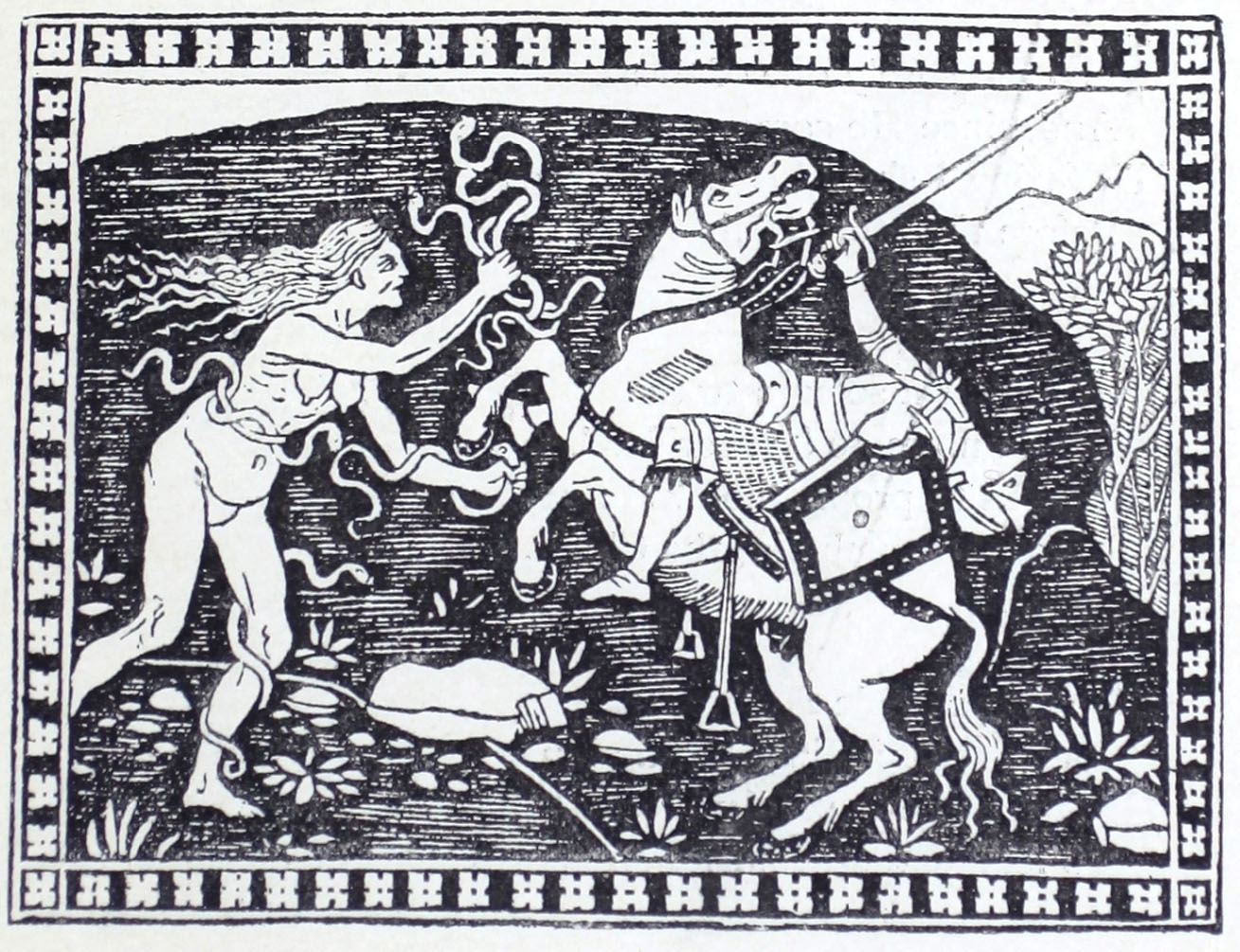
MLA citation:
Pollard, Alfred W. “Florentine Rappresentazioni and Their Pictures.” The Pageant, 1896, pp. 163-183. Pageant Digital Edition, edited by Frederick King and Lorraine Janzen Kooistra, 2019-2021. Yellow Nineties 2.0, Ryerson University Centre for Digital Humanities, 2021. https://1890s.ca/pag1-pollard-florentine/